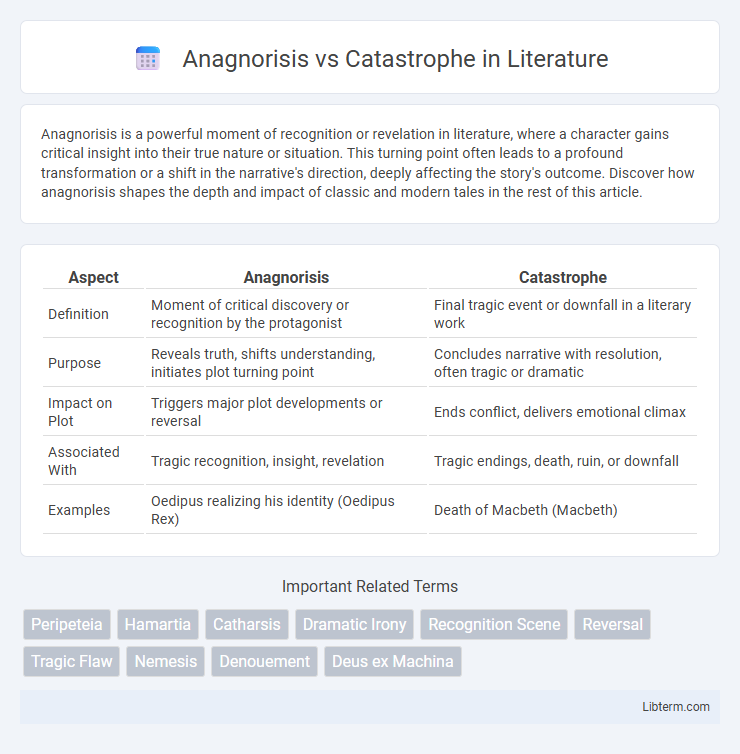Anagnorisis is a powerful moment of recognition or revelation in literature, where a character gains critical insight into their true nature or situation. This turning point often leads to a profound transformation or a shift in the narrative's direction, deeply affecting the story's outcome. Discover how anagnorisis shapes the depth and impact of classic and modern tales in the rest of this article.
Table of Comparison
| Aspect | Anagnorisis | Catastrophe |
|---|---|---|
| Definition | Moment of critical discovery or recognition by the protagonist | Final tragic event or downfall in a literary work |
| Purpose | Reveals truth, shifts understanding, initiates plot turning point | Concludes narrative with resolution, often tragic or dramatic |
| Impact on Plot | Triggers major plot developments or reversal | Ends conflict, delivers emotional climax |
| Associated With | Tragic recognition, insight, revelation | Tragic endings, death, ruin, or downfall |
| Examples | Oedipus realizing his identity (Oedipus Rex) | Death of Macbeth (Macbeth) |
Understanding Anagnorisis: Definition and Origins
Anagnorisis, a pivotal concept in classical Greek tragedy, refers to the moment of critical discovery or recognition when a character gains essential knowledge about their true nature or situation. Originating from Aristotle's "Poetics," it serves as a turning point that dramatically shifts the plot and deepens the emotional impact of the narrative. This realization often leads to the subsequent catastrophe, the disastrous conclusion resulting from the protagonist's earlier mistakes or flaws.
Catastrophe in Literature: Meaning and Function
Catastrophe in literature refers to the final resolution or denouement of a dramatic plot, often involving a tragic downfall or disaster for the protagonist. It serves to evoke strong emotional responses such as pity and fear, bringing the narrative to a climactic close. This moment often highlights the consequences of the characters' flaws or decisions, reinforcing the moral or thematic message of the work.
Key Differences Between Anagnorisis and Catastrophe
Anagnorisis is the critical moment of recognition or discovery in a narrative where a character gains crucial insight, often about their true nature or situation, while catastrophe refers to the final tragic event or downfall that concludes a tragedy. The key difference lies in their narrative function: anagnorisis serves as a turning point that triggers a shift in the plot or character development, whereas catastrophe represents the irreversible consequence or climax resulting from preceding actions. Both are essential components of classical tragedy but operate at distinct stages--anagnorisis initiates clarity, catastrophe culminates in resolution.
Historical Context: Classical Tragedy and Aristotle
Anagnorisis and catastrophe are pivotal elements in classical tragedy, deeply analyzed by Aristotle in his "Poetics," where anagnorisis refers to the protagonist's critical moment of recognition or insight, often leading to the shift in the plot. Catastrophe denotes the final unraveling or downfall, typically resulting in the hero's ruin or death, epitomizing the tragic conclusion fundamental to Greek drama. Aristotle emphasized their importance in evoking catharsis, a profound emotional purging in the audience that defines classical tragedy's impact and purpose.
How Anagnorisis Shapes Character Development
Anagnorisis, the moment of critical discovery or recognition, profoundly shapes character development by revealing essential truths that drive the protagonist's transformation and moral growth. This pivotal insight often triggers a deep self-awareness, allowing the character to confront internal flaws or external realities that were previously misunderstood. In contrast, catastrophe marks the collapse following these revelations, emphasizing the consequences but not the developmental journey initiated by anagnorisis.
The Role of Catastrophe in Plot Structure
Catastrophe serves as the climactic turning point in classical plot structure, where the protagonist faces a decisive crisis or downfall, essential for delivering emotional impact and thematic resolution. This event often follows the anagnorisis, a moment of critical recognition or revelation that intensifies the stakes and propels the narrative toward its resolution. The interplay between anagnorisis and catastrophe solidifies the tragic framework, emphasizing character transformation and the consequences of fate or hubris.
Famous Examples of Anagnorisis in Literature
Famous examples of anagnorisis in literature include Sophocles' "Oedipus Rex," where Oedipus realizes his true parentage and his role in the tragedy, and Shakespeare's "King Lear," in which Lear recognizes his mistakes and the true nature of his daughters. Unlike catastrophe, which refers to the final tragic event or downfall, anagnorisis is the critical moment of recognition or revelation that often precedes the catastrophe. These moments of anagnorisis deepen the emotional impact and highlight the themes of fate and self-awareness in classical and modern tragedies.
Memorable Catastrophes: Literature’s Most Impactful Endings
Memorable catastrophes in literature often mark the protagonist's anagnorisis, where the tragic recognition of truth intensifies the emotional impact of the story's conclusion. Iconic examples include Shakespeare's "Macbeth," where Macbeth's realization of his doomed fate coincides with a devastating downfall, and Sophocles' "Oedipus Rex," where Oedipus' discovery of his true identity triggers a catastrophic unraveling of his life. These powerful endings exemplify how the interplay between anagnorisis and catastrophe creates lasting resonance in literary narratives.
The Interplay Between Anagnorisis and Catastrophe
Anagnorisis, the pivotal moment of recognition or revelation, often triggers the subsequent catastrophe, a devastating unraveling of a character's fate in classical tragedy. The interplay between anagnorisis and catastrophe heightens dramatic tension by revealing hidden truths that precipitate irreversible consequences, intensifying emotional impact. This dynamic relationship underscores the tragic structure, as the protagonist's newfound awareness directly leads to downfall, emphasizing fate's inescapable nature.
Modern Interpretations: Anagnorisis and Catastrophe Today
Modern interpretations of anagnorisis emphasize its role as a moment of self-realization or truth recognition that drives character development, often depicted through psychological insight or moral awakening. Catastrophe is viewed less as mere tragic downfall and more as a complex, sometimes ambiguous resolution that reflects contemporary themes like existential crisis or societal collapse. Together, these elements illustrate how narrative structures adapt to current cultural contexts, highlighting personal and collective transformation.
Anagnorisis Infographic

 libterm.com
libterm.com